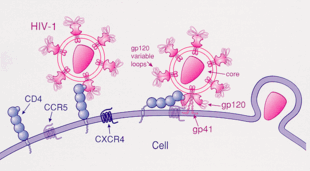
Back CCR5 Arabic CCR5 BS CCR5 German CCR5 Spanish CCR5 Basque Ccr5 Finnish CCR5 French CCR5 ID CCR5 Italian CCR5 Japanese

C-C chemokine receptor type 5, also known as CCR5 or CD195, is a protein on the surface of white blood cells that is involved in the immune system as it acts as a receptor for chemokines.[5]
In humans, the CCR5 gene that encodes the CCR5 protein is located on the short (p) arm at position 21 on chromosome 3. Certain populations have inherited the Delta 32 mutation, resulting in the genetic deletion of a portion of the CCR5 gene. Homozygous carriers of this mutation are resistant to infection by macrophage-tropic (M-tropic) strains of HIV-1.[6][7][8][9][10][11]
- ^ a b c GRCh38: Ensembl release 89: ENSG00000160791 – Ensembl, May 2017
- ^ a b c GRCm38: Ensembl release 89: ENSMUSG00000079227 – Ensembl, May 2017
- ^ "Human PubMed Reference:". National Center for Biotechnology Information, U.S. National Library of Medicine.
- ^ "Mouse PubMed Reference:". National Center for Biotechnology Information, U.S. National Library of Medicine.
- ^ Jiao X, Nawab O, Patel T, Kossenkov AV, Halama N, Jaeger D, et al. (October 2019). "Recent Advances Targeting CCR5 for Cancer and Its Role in Immuno-Oncology". Cancer Research. 79 (19): 4801–4807. doi:10.1158/0008-5472.CAN-19-1167. PMC 6810651. PMID 31292161.
- ^ de Silva E, Stumpf MP (December 2004). "HIV and the CCR5-Delta32 resistance allele". FEMS Microbiology Letters. 241 (1): 1–12. doi:10.1016/j.femsle.2004.09.040. PMID 15556703.
- ^ Hütter G, Nowak D, Mossner M, Ganepola S, Müssig A, Allers K, et al. (February 2009). "Long-term control of HIV by CCR5 Delta32/Delta32 stem-cell transplantation". The New England Journal of Medicine. 360 (7): 692–698. doi:10.1056/NEJMoa0802905. PMID 19213682.
- ^ Allers K, Hütter G, Hofmann J, Loddenkemper C, Rieger K, Thiel E, et al. (March 2011). "Evidence for the cure of HIV infection by CCR5Δ32/Δ32 stem cell transplantation". Blood. 117 (10): 2791–2799. doi:10.1182/blood-2010-09-309591. PMID 21148083.
- ^ Zhen A, Kitchen S (December 2013). "Stem-cell-based gene therapy for HIV infection". Viruses. 6 (1): 1–12. doi:10.3390/v6010001. PMC 3917429. PMID 24368413.
- ^ Kay MA, Walker BD (March 2014). "Engineering cellular resistance to HIV". The New England Journal of Medicine. 370 (10): 968–969. doi:10.1056/NEJMe1400593. PMID 24597871.
- ^ Tebas P, Stein D, Tang WW, Frank I, Wang SQ, Lee G, et al. (March 2014). "Gene editing of CCR5 in autologous CD4 T cells of persons infected with HIV". The New England Journal of Medicine. 370 (10): 901–910. doi:10.1056/NEJMoa1300662. PMC 4084652. PMID 24597865.
© MMXXIII Rich X Search. We shall prevail. All rights reserved. Rich X Search




